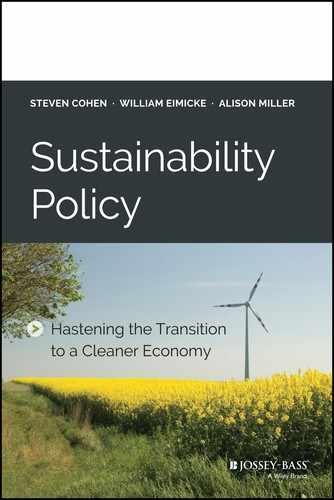Book Description
A complete guide to sustainability policy at the federal, state, and local levelsSustainability Policy: Hastening the Transition to a Cleaner Economy is a fundamental guide for public sector professionals new to sustainability policy development, implementation, strategy, and practice. Featuring detailed cases highlighting innovative sustainability initiatives, this book explores the elements that constitute effective policy, and the factors that can help or hinder implementation and adoption. Readers gain insight into policies in effect at the federal, state, and local levels, in the areas of water, energy, material use, and waste management, and the reasons why local policies are often the most innovative and successful. Discussion surrounding monitoring and measurement addresses the lack of standardization, as well as the government's critical role in leading the field toward generally accepted sustainability metrics, while outlining the reasons why certain policies are more feasible than others.
This book is an introductory resource, written in non-technical language, and organized in a coherent manner that establishes foundational knowledge before introducing more complex issues. Even readers with little background in sustainability will gain insight into the current state of the field and the issues at hand.
- Understand sustainability in public and private enterprises, including the role of government and public policy
- Learn the current standing federal, state, and local policies surrounding sustainability
- Discover what makes an effective sustainability policy, including measurement and evaluation metrics
- Explore the politics and future of sustainability, and the barriers to change
Sustainability is a hot topic in both the public and private sector, with vocal advocates on both sides of every issue, so developing effective policy is crucial. For public sector professionals entering the sustainability field, Introduction to Sustainability Policy & Management is a valuable resource.
Table of Contents
- Cover
- Title Page
- Copyright
- Dedication
- Preface: The Role of Government in the Transition to a Sustainable Economy
- Acknowledgments
- Chapter 1: What is Sustainability Management?
- Introduction
- The Challenges of Sustainability
- Sustainability Management
- The Evolution of the Environmental Movement
- The Sustainability Perspective
- Evolution of Organizational Management
- The Growing Momentum behind Sustainability Management
- The Expansion of Corporate Sustainability
- Sustainable Cities
- Measuring Sustainability
- Toward a Sustainable, Renewable Economy
- Chapter 2: Why We Need Sustainability Public Policy
- Introduction
- The Need for a Renewable Energy Economy
- The Different Functions of the Public, Private, and Nonprofit Sectors
- Limitations of the Private Sector in Addressing Long-Term Sustainability
- Role of the Government in Building a Sustainable Economy
- Working to Ensure the Transition is Well Managed
- Chapter 3: Policy Levers for Sustainability: The Federal Level
- Chapter 4: Policy Levers for Sustainability: The State Level
- Chapter 5: Policy Levers for Sustainability: The Local Level
- Chapter 6: Sustainability Measurement and Metrics
- Chapter 7: The Politics of Sustainability
- Chapter 8: Conclusion
- References
- About the Authors
- Index
- End User License Agreement
